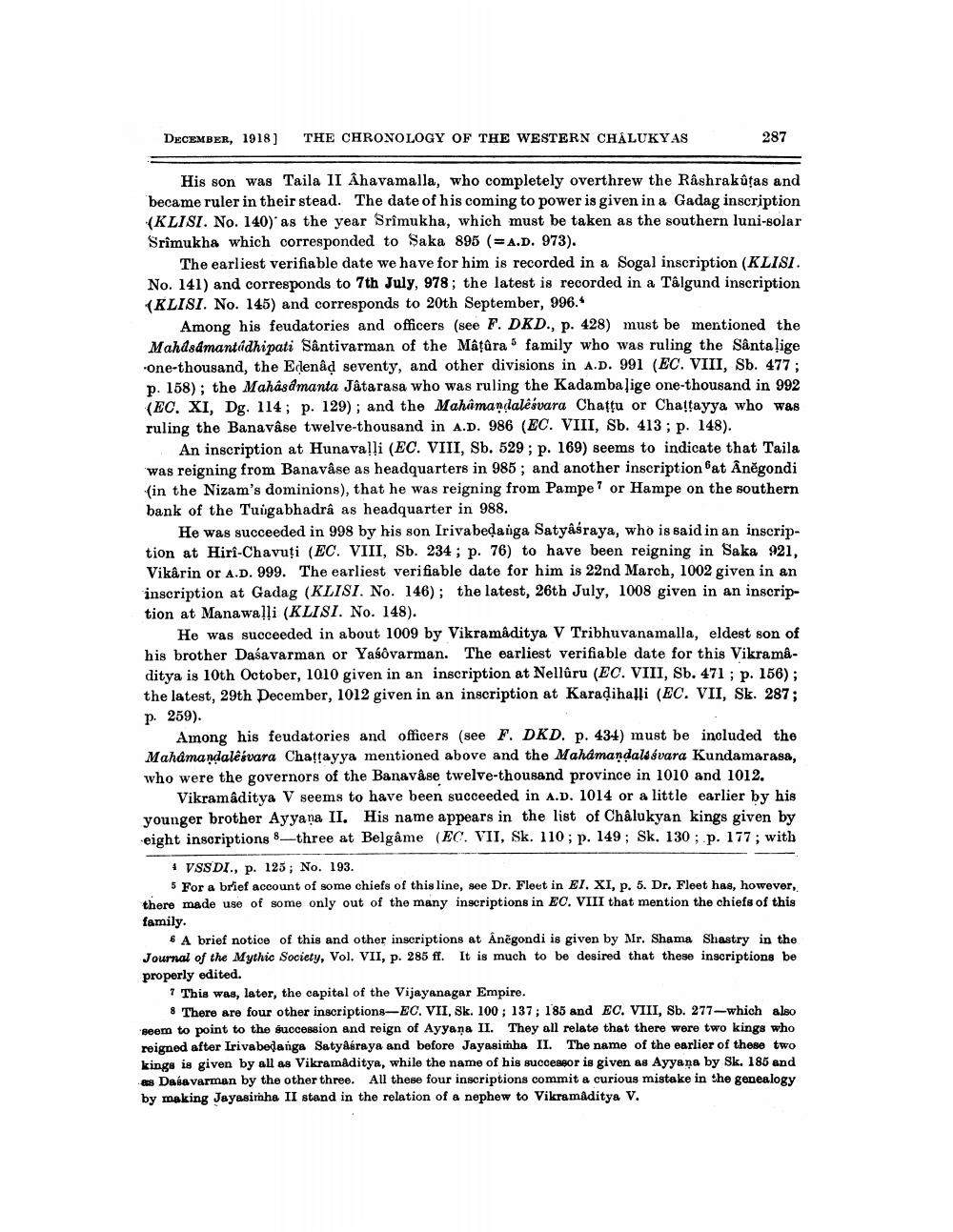________________
DECEMBER, 1918)
THE CHRONOLOGY OF THE WESTERN CHÂLUKYAS
287
His son was Taila II Âhavamalla, who completely overthrew the Råshrakûtas and became ruler in their stead. The date of his coming to power is given in a Gadag inscription (KLISI. No. 140)' as the year Srimukha, which must be taken as the southern luni-solar Srimukha which corresponded to Saka 895 (= A.D. 973).
The earliest verifiable date we have for him is recorded in a Sogal inscription (KLISI. No. 141) and corresponds to 7th July, 978; the latest is recorded in a Tálgund inscription (KLISI. No. 145) and corresponds to 20th September, 996.
Among his feudatories and officers (see F. DKD., p. 428) must be mentioned the Mahdsdmantadhipati Sântivarman of the Mâțûra family who was ruling the Sântalige one-thousand, the Edenad seventy, and other divisions in A.D. 991 (EC. VIII, Sb. 477; p. 158): the Mahasamanta Jatarasa who was ruling the Kadambalige one-thousand in 992 (EC. XI, Dg. 114; p. 129); and the Mahamandalesvara Chatu or Chaitayya who was ruling the Banavâse twelve-thousand in A.D. 986 (EC. VIII, Sb. 413; p. 148).
An inscription at Hunavalli (EC. VIII, Sb. 529; p. 169) seems to indicate that Taila was reigning from Banavâse as headquarters in 985; and another inscription at Âněgondi (in the Nizam's dominions), that he was reigning from Pampe? or Hampe on the southern bank of the Tuigabhadrâ as headquarter in 988.
He was succeeded in 998 by his son Irivabedanga Satyasraya, who is said in an inscription at Hiri-Chavuți (EC. VIII, Sb. 234 ; p. 76) to have been reigning in Saka 921, Vikârin or A.D. 999. The earliest verifiable date for him is 22nd March, 1002 given in an inscription at Gadag (KLISI. No. 146); the latest, 26th July, 1008 given in an inscription at Manawalli (KLISI. No. 148).
He was succeeded in about 1009 by Vikramaditya V Tribhuvanamalla, eldest son of his brother Daśavarman or Yasovarman. The earliest verifiable date for this Vikramaditya is 10th October, 1010 given in an inscription at Nellûru (EC. VIII, Sb. 471 ; p. 156): the latest, 29th December, 1012 given in an inscription at Karadihalli (EC. VII, Sk. 287; p. 259).
Among his feudatories and officers (see F. DKD. p. 434) must be included the Mahamandalesvara Chattayya mentioned above and the Mahamandalesvara Kundamarasa, who were the governors of the Banavâse twelve-thousand province in 1010 and 1012.
Vikramaditya V seems to have been succeeded in A.D. 1014 or a little earlier by his younger brother Ayyana II. His name appears in the list of Châlukyan kings given by eight inscriptions 8_three at Belgâme (EC. VII, Sk. 110; p. 149; Sk. 130; p. 177; with
VSS DI., p. 125; No. 193.
5 For a brief account of some chiefs of this line, see Dr. Fleet in EI, XI, p. 5. Dr. Fleet has, however, there made use of some only out of the many inscriptions in EC. VIII that mention the chiefs of this family.
6 A brief notice of this and other inscriptions at Anēgondi is given by Mr. Shama Shastry in the Journal of the Mythic Society, Vol. VII, p. 285 ff. It is much to be desired that these inscriptions be properly edited.
* This was, later, the capital of the Vijayanagar Empire.
8 There are four other inscriptions-EC. VII, Sk. 100; 137; 185 and EC. VIII, Sb. 277-which also seem to point to the succession and reign of Ayyana II. They all relate that there were two kings who reigned after Irivabedanga Satyasraya and before Jayasimha II. The name of the earlier of these two kings is given by all as Vikramaditya, while the name of his successor is given as Ayyana by Sk. 185 and es Dabavarman by the other three. All these four inscriptions commit a curious mistake in the genealogy by making Jayasirha II stand in the relation of a nephew to Vikramaditya V.




